 Research Article
Research Article
Technology of Preparation of Metal Parts for Heat- Resistant Coating
VP Smolentsev1*, EV Panichev2 and SV Safonov3
1Doctor of Technical Sciences, Professor, Voronezh State Technical University, Voronezh, Russia
2Postgraduate Student, Voronezh State Technical University, Russia
3Doctor of Technical Sciences, First Vice-Rector, Voronezh State Technical University, Russia
VP Smolentsev, Doctor of Technical Sciences, Professor, Laureate of the Russian Government prize, Honored inventor of Russia, Honored worker of Higher education of Russia, Honored Creator of space technology, Voronezh state technical University, Voronezh, Russia.
Received Date: July 28, 2019; Published Date: August 06, 2019
Abstract
The technological process of surface preparation for heat-shielding coating on the heat-loaded part of the combustion chamber of a liquid rocket engine is Considered. The proposed coating has several layers: internal metal, in contact with the part or substrate, and external, from a mixture of ceramic granules and metal powder. At the same time, to obtain the initial surface for the coating with the required surface layer roughness, it is proposed to use the method of blasting with abrasive grain. The article analyzes the possible mechanisms of formation of transition zones: base – coating - as well as the influence of their chemical composition on the adhesive strength of the layers. The choice of brand and combination of materials used for coating is justified. The technological modes that have been tested in production conditions when applying heat-resistant coatings on parts of modern rocket engines are proposed. The influence of modes of deposition of multilayer heat-resistant coatings and characteristics of technological equipment for the performance of products The influence of the technological parameters of the initial surface preparation process and the geometry of the obtained substrate microrelief on the adhesive characteristics of the multilayer coating operating in the high-temperature zone of the combustion chamber of liquid rocket engines is revealed.
Introduction
Modern missile systems are designed considering reusable use, which can significantly reduce the cost of subsequent launches. At the same time, the thermal load on the fire walls of the combustion chambers (CS) of liquid rocket engines increases, which requires their protection from multiple thermal effects and the development of special coatings. One of the effective ways to increase the life of the most heat-loaded elements of the CS is the application of multilayer heat-resistant coatings [1,2], which have good erosion resistance and high thermal resistance in conditions of intensive exposure to high-temperature combustion products. The defining characteristic of such coatings is the adhesive strength of adhesion to the substrate, the quality of which depends on the preparation of the surface of the part under the coating Justification of methods of applying heat-resistant coatings Combustion chamber and jet nozzle (Figure 1) have a complex geometric profile and works with a large range of temperatures generated during combustion of the fuel. The technological process of plasma coating containing powders includes several operations [3,4], surface preparation, application of a sublayer (if necessary) and a layer of heat-resistant coating, and in some cases -subsequent mechanical and thermal treatment.
Obtained for products in Figure 1 the coating is characterized by the following indicators to be monitored to assess the quality of the hot zone of the engine: the strength of adhesion to the substrate; the cohesive strength of the applied layer; the uniformity of the coating thickness; minimum and adjustable porosity; the level of residual stresses. One of the main characteristics of the resistance of heat-resistant coatings applied in this way is the adhesion to the substrate (the surface of the part). To do this, before applying them, it is necessary to create an artificial roughness that increases the adhesive strength of the layers. For parts of variable complex profile, such as shown in Figure 1, usually used abrasive-jet sand treatment with the required characteristics, in which the surface under the coating is cleaned of defective elements of the surface layer, dirt, oils.
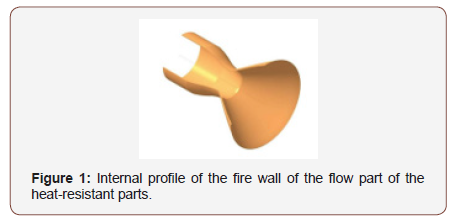
When applying materials with sharply different properties (ceramics on metals, materials with significantly different thermal expansion coefficients), it is necessary to coordinate the characteristics of the coating and the base, which is carried out by spraying the sublayer having intermediate properties. To do this, the sublayer must be more fusible and thinner, as well as not to have a tangible impact on the processes in the contact area during the operation of the product.
Materials Used for Coating
The inner shell of the combustion chamber and the jet nozzle are made of brh08 bronze, which has high thermal conductivity and provides the possibility of high-quality preparation of the surface layer for coating. Analysis of sources [1,4], numerous experiments have shown that it is advisable to use as a coating material: for the first layer – metal powder of the brand PH20N80 produced according to GOST 13084-88, for the outer – a mechanical mixture of granules of mineral ceramics with metal.
Ensuring the Quality of Surface Preparation and Evaluation of its Impact on the Adhesive Strength of the Coating
The adhesion strength of the coating adhesion to the substrate obtained during spraying depends on the purity of the surface to be sprayed, its configuration and microrelief. The performed operation, as a rule sandblasting, is performed by impact on the initial surface of solid granules of electro corundum, silicon carbide, iron chips and other materials. When the shock is formed is rough, the micro-relief of plastically deformed layer.
The parameters of the microrelief depend on the characteristics of the part, the size and shape of the granules, their flow rate per unit surface, the collision rate with the base and the angle of attack.
When used for sandblasting grinding grain with granules of a larger fraction significantly increases the roughness of the treated surface, resulting in the extrusion of the copper base over the abrasive granules. This makes the base on which the coating is applied excessively uneven, which violates the uniformity of the projections and worsens the adhesive strength of the samples shown in Figure 2.
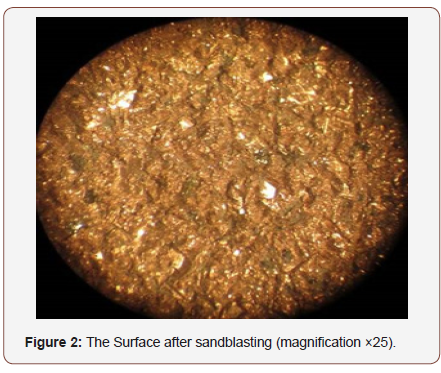
For Figure 2 shows a General picture of the formation of the surface, where you can see the local protrusions of great height, reducing the effective contact area of the coating layers and violate their adhesive strength. This contributes to phorone protective coating, especially with multiple launches of products.
For Figure 3 shows fractograms cross section microsection of sample with a cermet coating and a nichrome layer on a copper substrate treated with silicon carbide grit F46.
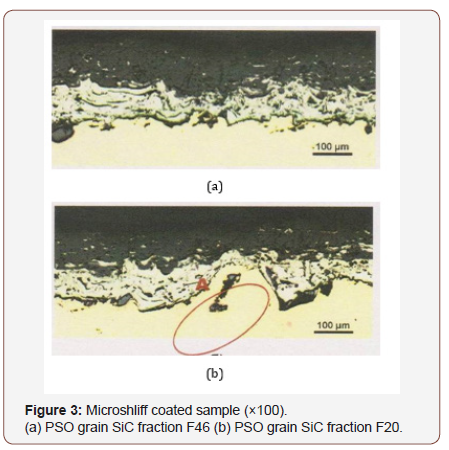
The results of the measurement of the surface roughness parameters of the samples, which showed their direct dependence on the applied fraction of abrasive grain.
For fig.4 shows fractorama cross section microsection of sample with a cermet coating and a nichrome layer on a copper substrate treated On the surface of the sample slot, between the copper substrate and the nichrome sublayer, there is a 170μm section, which is initially identified as pore, but the study in the reflected electron mode found that this inclusion of silicon carbide, obtained as a result of abrasive-jet treatment. (a) shooting in the mode of reflected electrons, (b) shot in the mode of secondary electrons (Figure 4).
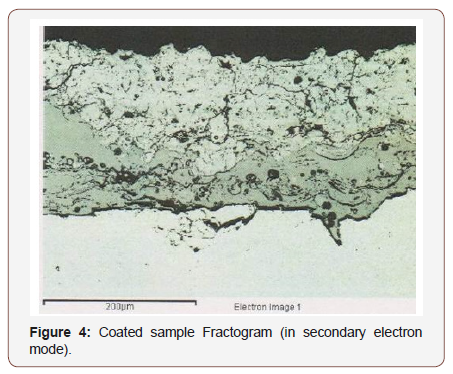
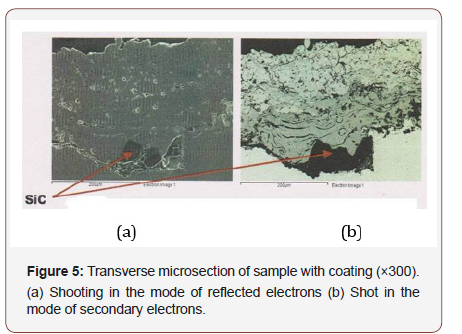
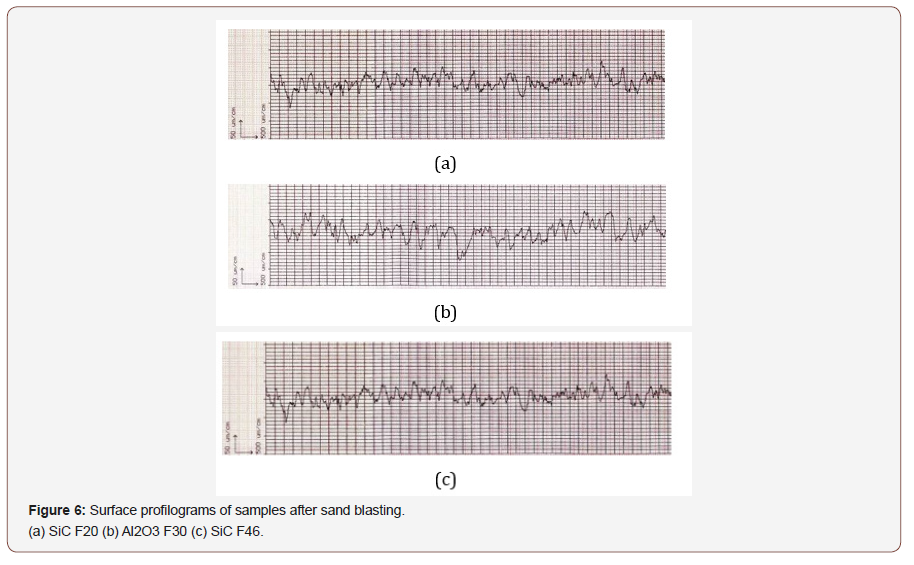
The measurements of the surface roughness parameters of the samples after PSO show their direct dependence on the applied fraction of abrasive grain.
To assess the effect of the resulting microrelief on the adhesive strength of the coating, the adhesive peel test method [3] Is available and gives satisfactory results for comparative tests. The tests on the adhesion strength obtained, their value varies in the range 9.5 to 11MPa.
According to the test results of the samples, it was found that there is a decrease in the adhesive strength of the coatings for separation for samples that have been sandblasted with silicon carbide of greater granularity (fraction F20). Studies have shown that when using white electro corundum, there is a decrease in the adhesion strength caused by the presence of easily destroyed minerals in it, some of which remain on the treated surface
Conclusion
The studies and the results obtained in the course of the work confirm the significant influence of the materials used for the preparation and surface treatment modes on the adhesive strength of the coating [4]. The increase in the surface roughness parameters, achieved through the use of abrasive grains of a larger fraction, leads to a decrease in adhesive strength for combinations of base and coating materials that do not have chemical affinity and implement the “anchor” type of engagement in the formation of the coating.
Acknowledgements
None.
Conflict of Interest
No conflict of interest.
References
- GV Samsonov, AP Epik (1973) Refractory coatings. G In Samsonov, AP Epic, Moscow: Metallurgy, p. 398.
- Baldaev LH (2007) Geothermal spraying. Moscow: Market DS, p. 344.
- Hasui A (1975) the Technique of spraying. Moscow: Mashinostroenie, p. 288.
- Smolentsev VP (2017) Design of technological processes for obtaining high-resource combined coatings/VP Smolentsev, MV Kondratiev, V Ivanov, Strengthening technologies and coatings 6: 273-281.
-
VP Smolentsev, EV Panichev, SV Safonov. Technology of Preparation of Metal Parts for Heat-Resistant Coating. Mod Concept Material Sci. 1(5): 2019. MCMS.MS.ID.000521.
-
Metal, Coating, Abrasive grain, Material, Adhesive Strength, Roughness
-

This work is licensed under a Creative Commons Attribution-NonCommercial 4.0 International License.






